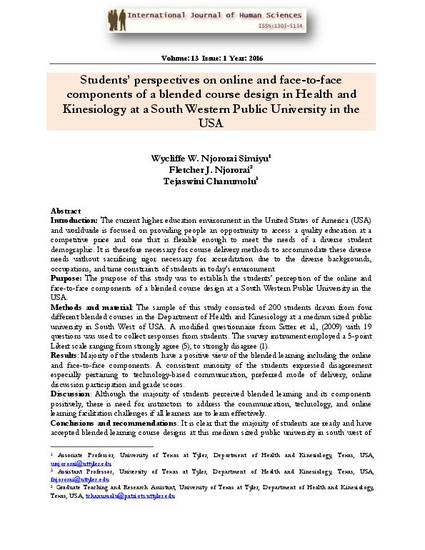
Introduction: The current higher education environment in the United States of America (USA) and worldwide is focused on providing people an opportunity to access a quality education at a competitive price and one that is flexible enough to meet the needs of a diverse student demographic. It is therefore necessary for course delivery methods to accommodate these diverse needs without sacrificing rigor necessary for accreditation due to the diverse backgrounds, occupations, and time constraints of students in today’s environment Purpose: The purpose of this study was to establish the students’ perception of the online and face-to-face components of a blended course design at a South Western Public University in the USA. Methods and material: The sample of this study consisted of 200 students drawn from four different blended courses in the Department of Health and Kinesiology at a medium sized public university in South West of USA. A modified questionnaire from Sitter et al., (2009) with 19 questions was used to collect responses from students. The survey instrument employed a 5-point Likert scale ranging from strongly agree (5), to strongly disagree (1). Results: Majority of the students have a positive view of the blended learning including the online and face-to-face components. A consistent minority of the students expressed disagreement especially pertaining to technology-based communication, preferred mode of delivery, online discussion participation and grade scores. Discussion: Although the majority of students perceived blended learning and its components positively, there is need for instructors to address the communication, technology, and online learning facilitation challenges if all learners are to learn effectively. Conclusions and recommendations: It is clear that the majority of students are ready and have accepted blended learning course designs at this medium sized public university in south west of the United States of America and therefore there is room for expansion of the initiative to benefit more students.
Available at: http://works.bepress.com/fletcher-njororai/5/
